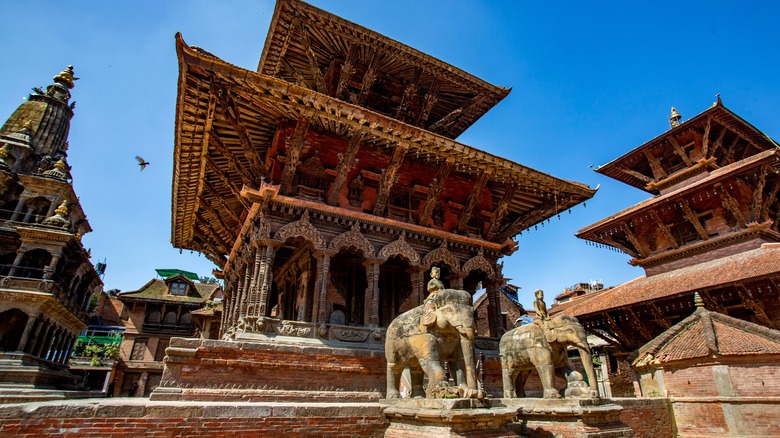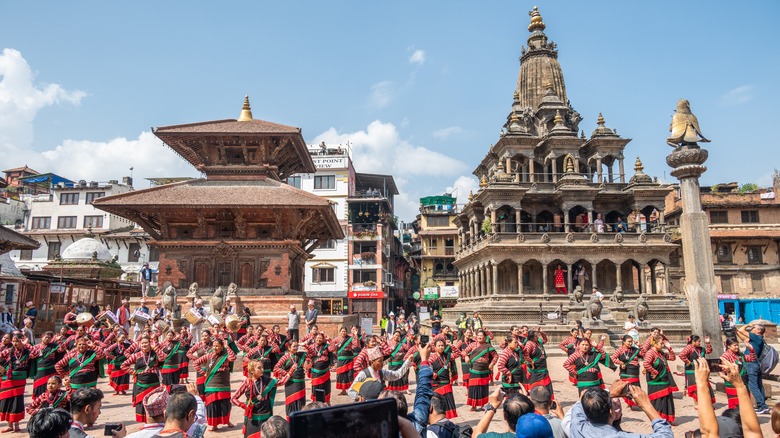Nepal's Charming 'City Of Artisans' Is An Exquisite Showcase Of Architecture And Handicrafts
Nepal's architecture is a marvel of history and craftsmanship, where tiered pagodas, carved wooden windows, and intricate stonework create an awe-inspiring setting to explore and admire. Among the finest examples of this artistic mastery is Patan, also called Lalitpur or Yala, depending on what tongue is spoken. Situated on the Kathmandu Valley plateau, Patan lies just across the Bagmati River, a mere 25-minute drive from Kathmandu, Nepal's largest city, known for its street feasts. While both cities share a rich cultural heritage, Patan stands out for its exceptional art and monuments, making it well worth a journey across the river.
Dubbed the "City of Artisans," Patan's craftsmanship stretches back centuries. This title is no exaggeration — Patan is often credited as the home of Araniko, the 13th-century architect whose influence spread across Asia, and Tej Bahadur Chitrakar, a pioneer of contemporary Nepalese painting. Walk its narrow streets, and you'll hear the rhythmic clang of metalworkers shaping statues, see artisans carefully carving wooden deities, and witness monks patiently arranging mandalas from sand. The city is a harmonious blend of Hindu and Buddhist traditions, where both faiths have left their mark through an incredible array of temples, shrines, and sculptures that fill the city with sacred beauty.
Admire the architectural wonders of Patan
Patan's origins trace back to the 3rd century B.C., but it thrived during the rule of the Malla dynasty — celebrated for its elaborate architecture — as a royal capital. One of the most striking remnants of this era is the Krishna Mandir temple, built by King Siddhi Narasingh Malla. This 3-tiered masterpiece features domed pavilions (chhatris), delicate stone carvings depicting Hindu epics, and finely sculpted statues of gods — an architectural highlight that showcases Nepal's fusion of religion and artistry.
Much of Patan is structured around courtyards, interconnected by winding alleyways. At the city's heart lies Patan Durbar Square, a UNESCO World Heritage site that once served as a Malla-era palace complex. Within the square, you'll find the stunning Sundari Chowk courtyard, where a sunken bath is adorned with over 72 stone carvings of Hindu deities. A short walk away, Keshav Narayan Chowk houses the Patan Museum, home to over 1,000 artifacts that tell the story of Nepal's Buddhist and Hindu history.
Beyond the square, Mahabouddha Temple is an unmissable sight. Built in the 14th century, this Buddhist sanctuary is covered in thousands of terracotta Buddha engravings. Another breathtaking Buddhist landmark is Kwa Baha, or the Golden Temple, which is among the ranks of the world's most surreal religious wonders. Inside this active monastery, you'll find an eclectic mix of influences: Arched gateways inset with Buddhas, European-style columns, a multi-tiered tower, and intricate metal work across shrines that shimmer under the flickering butter lamps. This is not just a historic site but a living place of worship, where monks and devotees gather for daily ceremonies.
Patan's markets, food, and festivals
Patan's artistic legacy isn't confined to its temples — it lives on in the city's thriving artisan workshops. Wander the streets, and you'll find craftsmen sculpting bronze statues and meticulously painting thangka artworks. Many of these handmade treasures can be purchased from local stores, such as Om Handicrafts, which specializes in healing bowls and jewelry. Around Kwa Baha temple and Patan Durbar Square, you'll stumble upon rows of shops and handicraft stalls selling everything from carved figurines to traditional oil lamps, making for perfect souvenirs to take home.
For a taste of authentic Newari cuisine, start at the Mhamadu Galli alleyway, near the Krishna Mandir temple, where two sweet shops serve jeri — a crispy, deep-fried swirled dough dipped in syrup, best enjoyed for breakfast. Just steps away, Honacha, a historic eatery praised by the Kathmandu Post, dishes out traditional choila (spiced buffalo meat) and bhatmas sadeko (spiced soybean salad).
For an unforgettable experience, time your visit around Rato Machindranath Jatra, Nepal's longest chariot festival, held around April and May every year. This grand event sees devotees pulling a towering chariot through Patan's streets in honor of the rain god Machindranath. However, Nepal is one of the best destinations for a December travel bucket list, too, offering crisp weather and clear skies. To reach this artisan city, you can fly into Tribhuvan International Airport (KTM) in Kathmandu and take a 20-minute drive to Patan.


